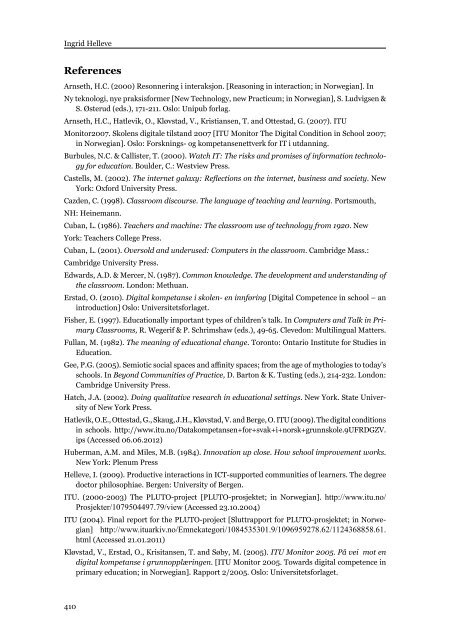Download issue - Umeå universitet
Download issue - Umeå universitet
Download issue - Umeå universitet
You also want an ePaper? Increase the reach of your titles
YUMPU automatically turns print PDFs into web optimized ePapers that Google loves.
Ingrid Helleve<br />
References<br />
Arnseth, H.C. (2000) Resonnering i interaksjon. [Reasoning in interaction; in Norwegian]. In<br />
Ny teknologi, nye praksisformer [New Technology, new Practicum; in Norwegian], S. Ludvigsen &<br />
S. Østerud (eds.), 171-211. Oslo: Unipub forlag.<br />
Arnseth, H.C., Hatlevik, O., Kløvstad, V., Kristiansen, T. and Ottestad, G. (2007). ITU<br />
Monitor2007. Skolens digitale tilstand 2007 [ITU Monitor The Digital Condition in School 2007;<br />
in Norwegian]. Oslo: Forsknings- og kompetansenettverk for IT i utdanning.<br />
Burbules, N.C. & Callister, T. (2000). Watch IT: The risks and promises of information technology<br />
for education. Boulder, C.: Westview Press.<br />
Castells, M. (2002). The internet galaxy: Reflections on the internet, business and society. New<br />
York: Oxford University Press.<br />
Cazden, C. (1998). Classroom discourse. The language of teaching and learning. Portsmouth,<br />
NH: Heinemann.<br />
Cuban, L. (1986). Teachers and machine: The classroom use of technology from 1920. New<br />
York: Teachers College Press.<br />
Cuban, L. (2001). Oversold and underused: Computers in the classroom. Cambridge Mass.:<br />
Cambridge University Press.<br />
Edwards, A.D. & Mercer, N. (1987). Common knowledge. The development and understanding of<br />
the classroom. London: Methuan.<br />
Erstad, O. (2010). Digital kompetanse i skolen- en innføring [Digital Competence in school – an<br />
introduction] Oslo: Universitetsforlaget.<br />
Fisher, E. (1997). Educationally important types of children’s talk. In Computers and Talk in Primary<br />
Classrooms, R. Wegerif & P. Schrimshaw (eds.), 49-65. Clevedon: Multilingual Matters.<br />
Fullan, M. (1982). The meaning of educational change. Toronto: Ontario Institute for Studies in<br />
Education.<br />
Gee, P.G. (2005). Semiotic social spaces and affinity spaces; from the age of mythologies to today’s<br />
schools. In Beyond Communities of Practice, D. Barton & K. Tusting (eds.), 214-232. London:<br />
Cambridge University Press.<br />
Hatch, J.A. (2002). Doing qualitative research in educational settings. New York. State University<br />
of New York Press.<br />
Hatlevik, O.E., Ottestad, G., Skaug, J.H., Kløvstad, V. and Berge, O. ITU (2009). The digital conditions<br />
in schools. http://www.itu.no/Datakompetansen+for+svak+i+norsk+grunnskole.9UFRDGZV.<br />
ips (Accessed 06.06.2012)<br />
Huberman, A.M. and Miles, M.B. (1984). Innovation up close. How school improvement works.<br />
New York: Plenum Press<br />
Helleve, I. (2009). Productive interactions in ICT-supported communities of learners. The degree<br />
doctor philosophiae. Bergen: University of Bergen.<br />
ITU. (2000-2003) The PLUTO-project [PLUTO-prosjektet; in Norwegian]. http://www.itu.no/<br />
Prosjekter/1079504497.79/view (Accessed 23.10.2004)<br />
ITU (2004). Final report for the PLUTO-project [Sluttrapport for PLUTO-prosjektet; in Norwegian]<br />
http://www.ituarkiv.no/Emnekategori/1084535301.9/1096959278.62/1124368858.61.<br />
html (Accessed 21.01.2011)<br />
Kløvstad, V., Erstad, O., Krisitansen, T. and Søby, M. (2005). ITU Monitor 2005. På vei mot en<br />
digital kompetanse i grunnopplæringen. [ITU Monitor 2005. Towards digital competence in<br />
primary education; in Norwegian]. Rapport 2/2005. Oslo: Universitetsforlaget.<br />
410

















